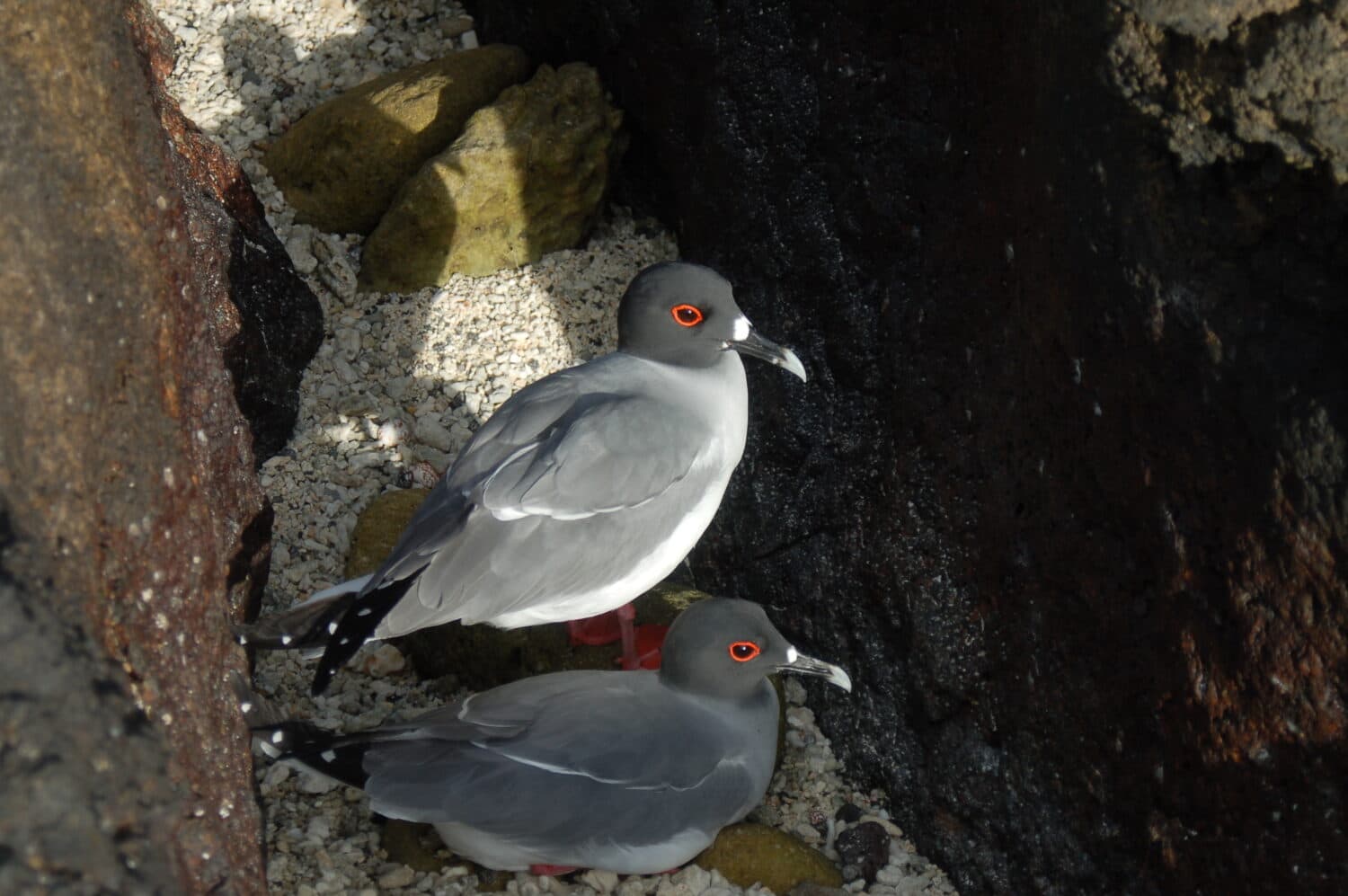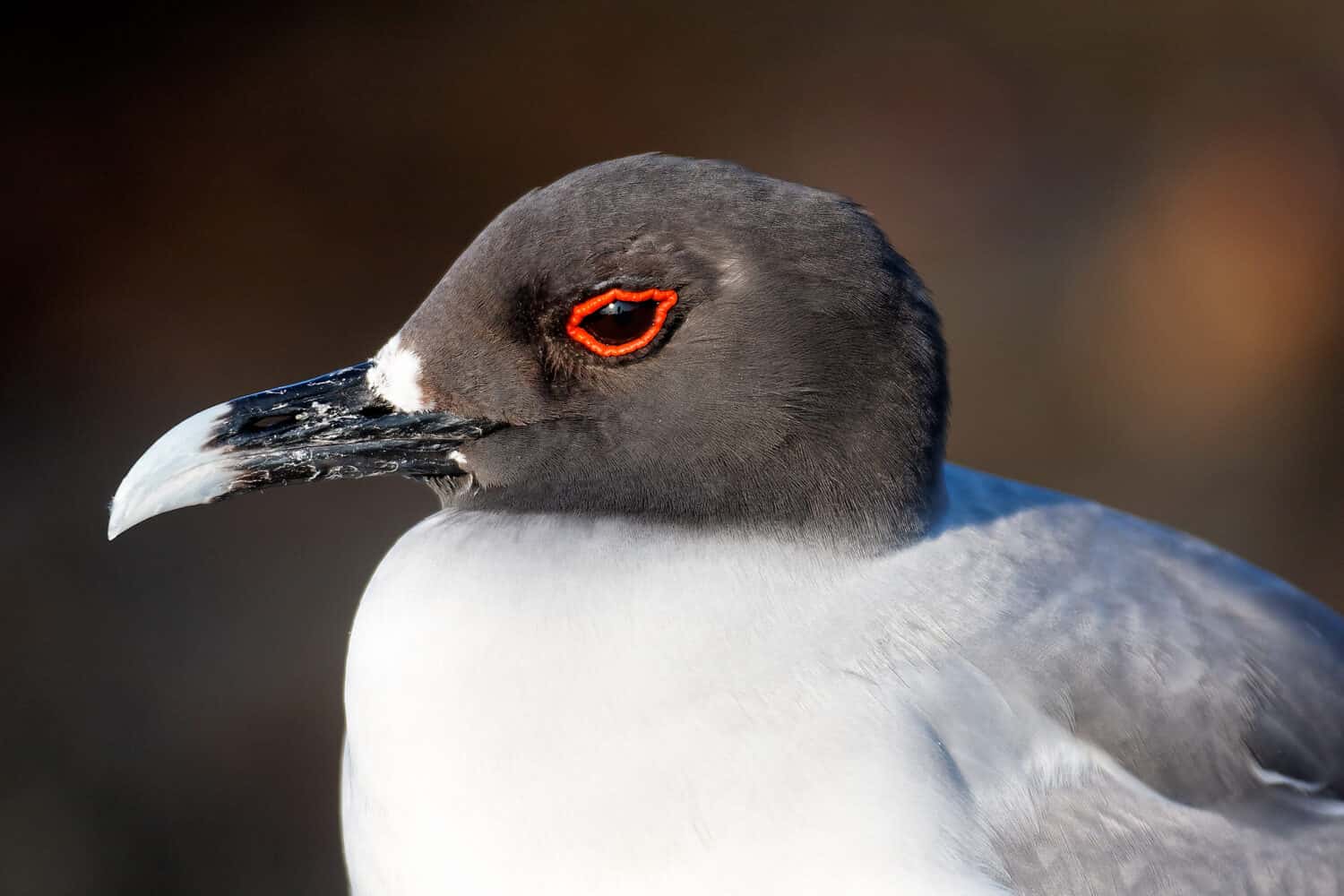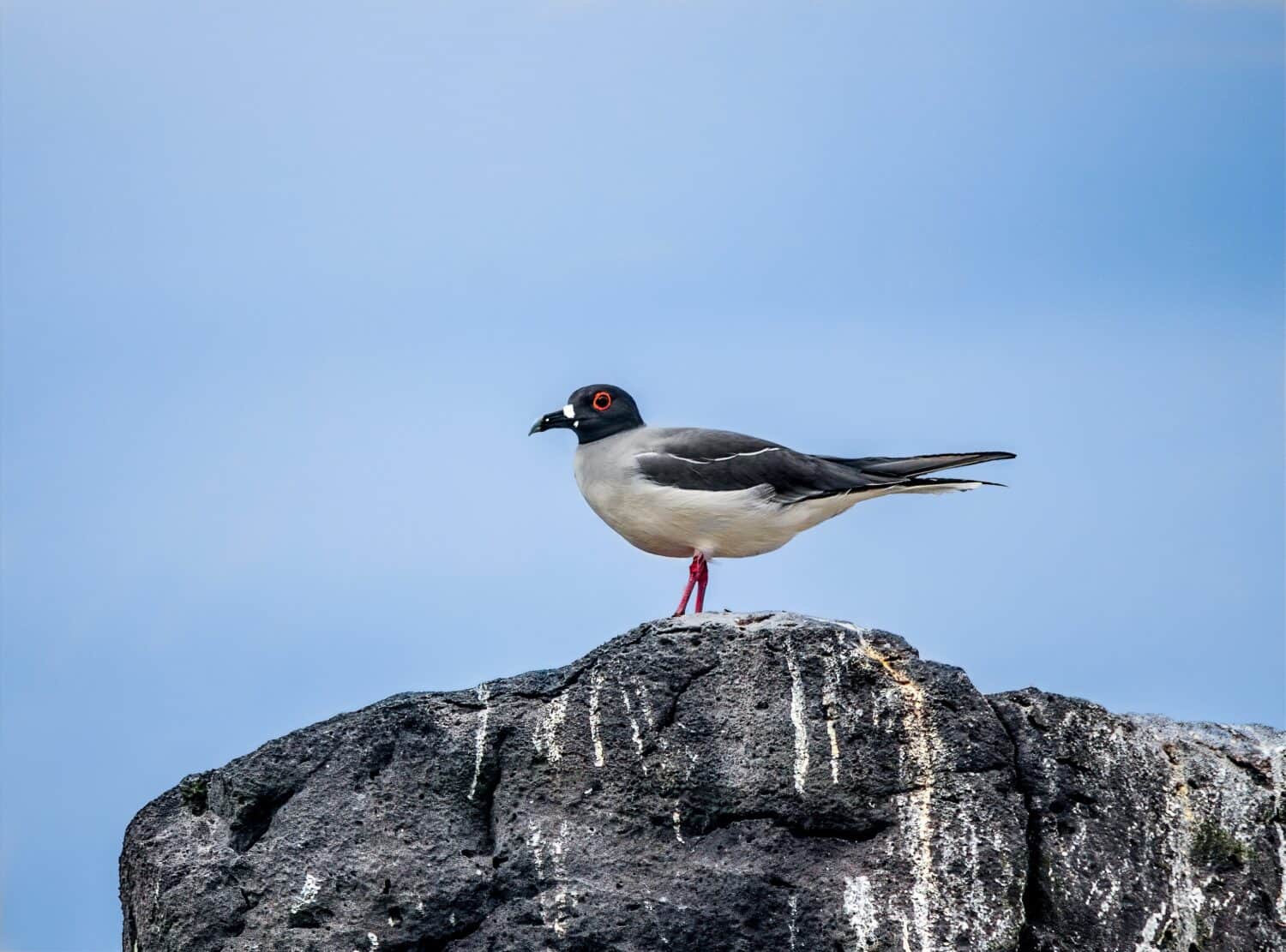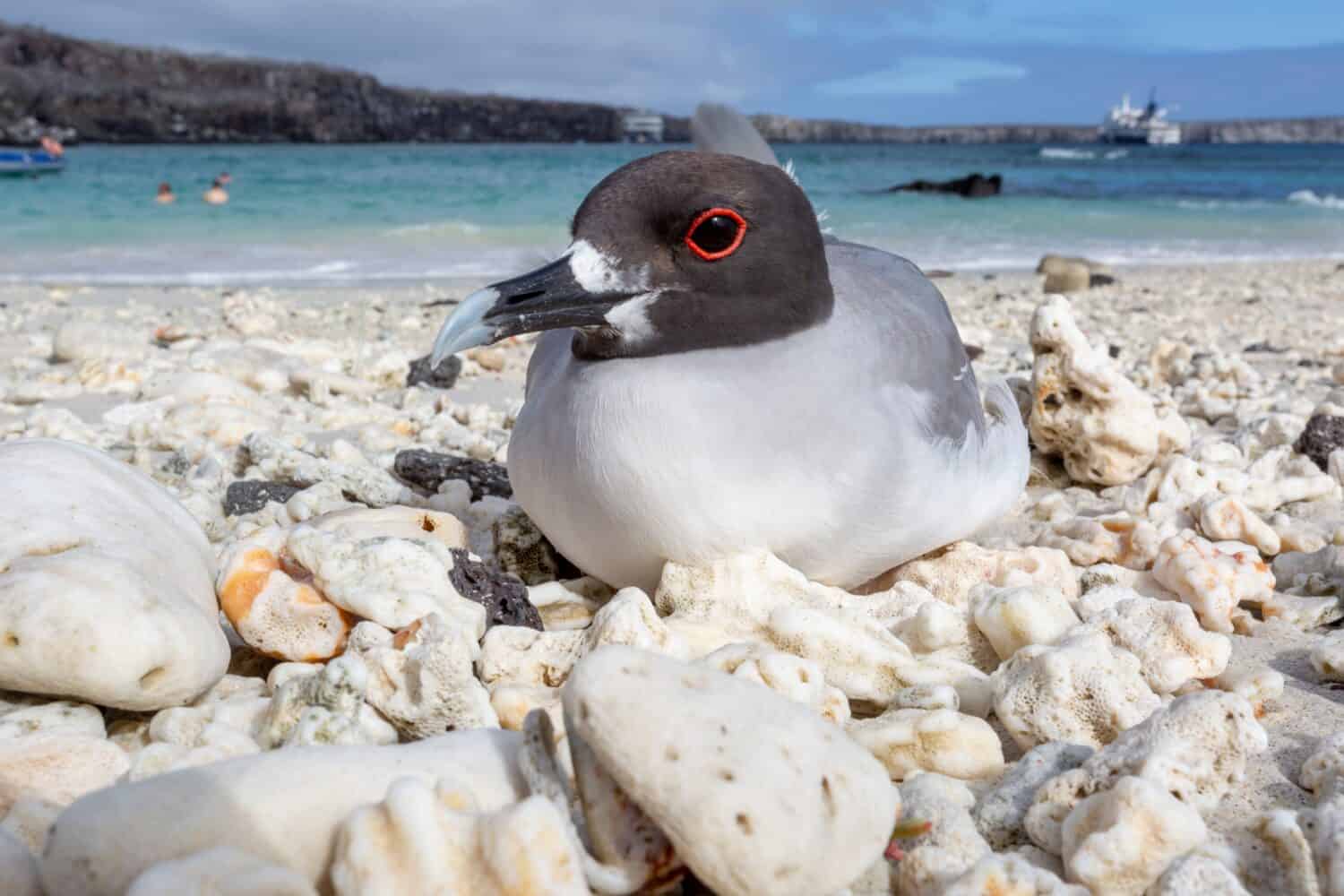When you think of a gull, you probably picture a white and grey bird scarfing down French fries at the beach. This, of course, isn’t an uncommon sight—but there is far more to gulls than just seaside snack stealers. Gulls are a widespread shorebird that breeds on every continent, including Antarctica. There are 50 different species of gulls around the world. Although many people refer to these birds as seagulls, this is a misnomer. None of the 50 species is actually named this. Gulls generally live in coastal regions, though some venture far out to sea, only coming on land to breed.
While each gull species is unique, the swallow-tailed gull (Creagrus furcatus) stands out among other birds. Native to the Galapagos Islands off the western coast of Ecuador, the swallow-tailed gull is a medium- to large-sized gull. It averages around 50-57 centimeters in height and 610-780 grams. Their curved black beak has a grey point and a white base. Their feather coloration changes depending on whether or not they are breeding: breeding adults have a black head, while non-breeding adults have a white one. A distinguishing feature of the gull is an eye ring that turns bright red when they are breeding.
Swallow-tailed gulls have many unique features that set them apart from other gulls, including their hunting habits, vision, breeding rituals, territory, and more. Here are eight wild facts about the swallow-tailed gull.
1. Swallow-Tailed Gulls Are the Only Nocturnal Gull

While all other gulls feed during the day, swallow-tailed gulls feed exclusively at night.
©Roberto Dani/Shutterstock.com
While most species of gull are diurnal (awake during the day), the swallow-tailed gull is nocturnal. It is the only gull that is active and hunts at night. This adaptation is advantageous for several reasons. By hunting at night, the gull avoids the competition of the ambitious (and larger) frigate birds that also hunt the waters of the Galapagos and off of South America. Additionally, the gull’s favorite food (squid) is most active at night. By hunting at night, gulls have greater access to food with less competition.
2. They Have Night Vision

The lunar cycle affects the feeding habits of nocturnal gulls, and they most often hunt under a new moon.
©Claudiovidri/Shutterstock.com
To successfully hunt at night, the swallow-tailed gull needs to be able to see. Luckily, these gulls are the only ones with night vision. The swallow-tailed gull has the largest eyes of any species of gull, which helps them see in the dark. Their eyes also have a special layer of tissue called the tapetum lucidum. This tissue allows them to see well in low light by reflecting light through the retina.
3. Their Eyes Do More Than See

While the red eye ring is a distinctive feature of swallow-tailed gulls, the ring is only red when they are in their breeding season, which can last 6 months.
©goran_safarek/Shutterstock.com
As if the gulls’ night vision isn’t impressive enough, their eyes also help them when it comes time for breeding. When the gull is ready to breed, the fleshy ring around its eye turns bright red. This indicates to other gulls that the bird is ready to mate. When not in the breeding season, the eye ring is black.
4. Swallow-Tailed Gills Are Endemic to the Galapagos

The Galapagos archipelago includes 13 primary islands, with smaller islands, rock formations, and isles totaling 127 islands.
©Maridav/Shutterstock.com
While there are 19 species of seabirds found in the Galapagos Islands, six of them (32%) are endemic. Swallow-tailed gulls, along with the Galapagos penguin, flightless cormorant, waved albatross, Galapagos shearwater, Galapagos petrel, and the lava gull, are endemic to the Islands. This means they are only found in the Galapagos and do not nest anywhere else in the world.
In addition to the six endemic seabirds, the Galapagos Islands are also home to 22 endemic species of land birds, five land mammals, two marine mammals, 20 reptiles, and countless endemic species of fish, invertebrates, and plants.
5. Cliffs Make a Good Home

While swallow-tailed gulls nest throughout the Galapagos, they prefer the eastern coasts where the water is warmer.
©Rajh.Photography/Shutterstock.com
There aren’t very many trees in the Galapagos, so during breeding season swallow-tailed gulls have adapted to nest on rock faces, cliffs, and lava rocks, primarily on the eastern coasts of the Islands. This also puts them on the coast, conveniently close to the ocean where they hunt for food.
Most nests are located within 30 feet of sea level, giving the birds easy access to the water. While they have individual nests, they often nest in large colonies on the cliff faces, with up to 30 breeding pairs well-spaced across around 2,000 square feet.
6. The Male Gull Builds the Nest

Swallow-tailed gulls only lay one single egg per breeding season.
©Leslie Russum/Shutterstock.com
Swallow-tailed gulls are what are called asynchronous breeders, meaning they have no set breeding season but will mate year-round. This means there are always gulls breeding, or getting ready to breed. Before breeding, however, they need to build a nest.
When it’s time to make a nest, the males are the ones getting busy. This is unlike most other species of bird, where the female is solely responsible for building a nest. For swallow-tailed gulls though, nest building is part of the way that males attract a mate. The male has a better chance of attracting a mate if he builds a good nest. To do this, he collects stones, coral, lava rock, and sea urchin spines. Often, he carries the stones by swallowing them and then regurgitating them back up on the nest site.
These collected materials form a barrier on the flat nest site to prevent the egg from rolling out of the nest. Once the male has collected all the necessary materials, he will sit in the middle of them and rotate back and forth to shape the nest to his liking.
7. They Will Road Trip for Meals

Pelagic gulls will commonly feed up to 18 miles from land.
©Danita Delimont/Shutterstock.com
When they aren’t breeding, swallow-tailed gulls will travel far and wide for food. They are pelagic, meaning they spend much of their time on the open ocean, often showing up hundreds of miles offshore. Swallow-tailed gulls primarily feed on small fish and squid, and they will travel far to reach rich feeding grounds. Remarkably, these gulls have been sighted as far from the Galapagos as mainland southern Peru and northern Chile—up to 2,500 miles from the Islands.
It is believed that gulls make this journey because squid are more plentiful to the south where they congregate in the cold Humboldt current. However, when it comes time to breed the gulls will return to the cliffs of the Galapagos.
8. Swallow-Tailed Gulls Aren’t Afraid of People

Because humans have never been a threat to them, swallow-tailed gulls have very little fear of people.
©Kendall Collett/Shutterstock.com
Like many animals in the Galapagos, swallow-tailed gulls do not have a fear of people and will not fly away if approached. However, they do face some threats. Galapagos hawks will often steal gull eggs from unguarded nests. When a gull senses a hawk or other threat, it will move its head from side to side and make a loud alarm call known as a “rattle-and-whistle.” This call is very distinctive and sounds like a long gurgling scream. When other gulls hear this call, they will join in, even if they don’t see the threat themselves.
Summary of Facts About Swallow-Tailed Gulls
| Fact | Description |
|---|---|
| 1. Swallow-tailed gulls are the only nocturnal gull | Swallow-tailed gulls hunt at night when squid are closer to the surface. |
| 2. They have night vision | A special layer of tissue in their eyes makes it easy for these gulls to see in low light. |
| 3. Their eyes do more than see | Red eye rings indicate when a gull is in the breeding season |
| 4. Swallow-tailed gulls are endemic to the Galapagos Islands | These gulls are one of the Islands’ six endemic seabirds. |
| 5. Cliffs make a good home | Swallow-tailed gulls nest on cliff faces, ledges, and rocky outcrops. |
| 6. The male gull builds the nest | Males build nests to attract females as part of the mating ritual. |
| 7. They will road trip for meals | Gulls have been found as far away as northern Chile, where they travel to find squid. |
| 8. They aren’t afraid of people | Like many species in the Galapagos, swallow-tailed gulls do not see humans as a threat. |
The photo featured at the top of this post is © Kendall Collett/Shutterstock.com
Thank you for reading! Have some feedback for us? Contact the AZ Animals editorial team.






